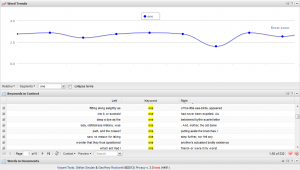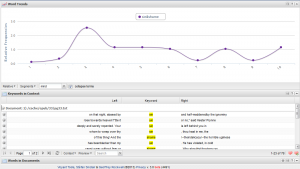Wordle and WordItOut
To start, I decided to place the text of The Scarlet Letter into Wordle and WordItOut and compare them side by side. Here are the clouds I created. First, Wordle:
Nothing too surprising here. And yes, I kept all the defaults. On to WordItOut:
I kept the layout simple for easy reading. As you can see, both word clouds are quite similar, and the content of the words isn’t surprising. Names are quite prevalent, with Hester and Pearl topping the list. Words like “Heart,” “Life,” and “Mother” get at the core issues of the novel. WordItOut represented quite a few more mundane words that don’t mean much on their own: “within,” “among,” “whether,” “indeed,” “even,” ect., while Wordle came up with more interesting results overall, though many of these words appear small due to their low frequency. In particular, the category of morality pops up, which shouldn’t be surprising for someone that has read the novel: “soul,” “sin,” “shame,” ect. Finally, while admittedly a common word, the large frequency of “One” is a bit puzzling, but something to take note of for later.
Up-Goer Five Text Editor
Up-Goer Five Text Editor is an interesting experiment in constraint. It does for the depth of language what Twitter does for length. It took a bit of rewriting before I got a definition of the Digital Humanities that didn’t seem horrible: “The use of computers in order to find new ways of doing and making while focusing on older ways of understanding.” Wow, does Up-Goer Five Text Editor require simplicity or what? Already I was ready for a few rejected words, so I put my results from WordItOut into the box and clicked enter. This is what I found:
Most of this isn’t too surprising. I did not expect names like Prynne and Chillingsworth to be among the ten hundred most used words. Moreover, words not in use anymore, such as “thee” and “thy,” were rejected, although I was surprised and disgusted by the rejection of “whom.” You would think a word like “itself” would appear, but this demonstrates just how limited you must make your vocabulary in order to use this tool. This was an amusing experiment, and the constraint works in a similarly way as Twitter, forcing the user to create something under set limitations.
CLAWS Part-of-Speech
Next, we move on to CLAWS part-of-speech tagger, which is a fun experiment, but not quite as amusing as the other tools. I would have appreciated a function that sorts the words of alike parts of speech together, but I suppose you cannot ask for everything. From what I can tell, there is actually a variety of parts of speech here, with proper nouns, reflexive pronouns (the prevalence of “self” is interesting), adverbs, singular nouns, prepositions, pronouns, and more. Could I have discovered this on my own? Probably. But CLAWS brings these facts to my attention as a way of sparking new questions or pursuing new areas of study. But for now I’ll leave CLAWS alone and move on to the final tool.
TAPoR
Trying out HyperPo and experimenting with different combinations of words was worthwhile. After fading through the first page of largely uninteresting words, I came across the word “One” once again. Equipped with this new tool, I decided to map out its presence throughout the text and perhaps account for it.
Yes, “One” is a common word and could have little significance. It could also be a particular vocabulary quirk of Hawthorne (or perhaps the era in which the book was written) to use “one” rather than “you” or “she” or “he,” or to refer back to a person. Certainly, this is the case. But there are numerous instances in which “One” serves a more interesting purpose. In sentences like “. . . deep a dye as the one betokened by the scarlet letter,” one is used to emphasize the unique suffering of Hester’s situation. Again, more likely Hawthorne uses “One” incidentally as part of his diction, but cases like these suggest the possibility of something more.
Next I decided to experiment with a more concrete idea. I selected “child” and “infant,” both of which refer to the character Pearl in the novel, and attempted to set them against each other on the graph. This did not work for some reason, so I was forced to look at them separately. As expected, “Infant” occurs almost entirely on the left side of the graph, the beginning of the novel, when Pearl is, well, and infant. Child, meanwhile, appears steadily throughout the novel, starting just after “infant” ends (with some overlap), as well as a slight dip in the set of chapters in which Pearl does not appear. This looks good. Despite the minor technical hiccup, HyperPo seems to be doing its job. Of course, in this case, I only set it to tell me something I already know, suggesting that I may not be asking the right questions. But this was an short experiment with the capabilities of the tool itself, so I have no choice but to forgive myself.
As one final experiment, I noticed that HyperPo allows you to collapse different words and view their frequency as one unit. I tried this with “sin” and “shame,” words associated with Hester’s scarlet letter:
As you can see, the greatest frequency of these words together occurs toward the beginning of the novel, while it fluctuates up and down before going up near the end. What can we determine from this graph alone? Perhaps the scarlet letter torments Hester most toward the beginning of the novel, during Pearl’s infancy. The passage at the end is also notable for the line,
. . . long since recognised the impossibility that any mission of divine and mysterious truth should be confided to a woman stained with sin, bowed down with shame, or even burdened with a life-long sorrow.
Focusing on these central themes at the end accounts for the tiny spike. Of course, I can verify none of this without directly consulting the novel, which further indicates the use of this tool as a form of provocation, a way of reshuffling the words of the text to raise interesting questions. In this sense, to “see through the text” involves a specific mapping which requires zeroing in specifically on finite sets of words. The experience of HyperPo is like reading a text with a powerful, magical magnifying glass that guides the reader to common and specific parts of the text. Okay, that analogy may not work as well as I was hoping, but I gave it a shot.
Conclusions
Overall, HyperPo is a robust tool that has a lot to offer, and I have of course only scratched the surface. Wordle and WordItOut are useful for expressing a main idea or message easily and succinctly, but I imagine HyperPo could be used for more serious research.
This exercise has taught me that one must be deliberate and careful while using these tools, provided that you want to come out with something useful. They can be used to confirm what you already know, which most would argue is quite boring. It takes a great deal of time and experimentation before coming out with a truly stunning result, and these are the ones that are the most worthwhile. These are the moments when you are able to look at a text in a new way, and this alone justifies the use of these tools.
In this sense, Ramsay’s these tools indeed create a sense of the “estrangement and defamiliarization of textuality” by forcing the reader to view a text in an entirely different way. For all of its simplicity, Wordle’s ability to recognize and display common words presents the text in its most basic form. No, this is not the same as reading The Scarlet Letter. Not even close. But as a tool of provocation, the re-shuffling and re-oganization of words could lead to new insights about the text. Perhaps HyperPo best demonstrates the capabilities of these sorts of tools for scholarship. I’m still not convinced that any of these tools can help us “Read a Million Books,” as they require the user to be familiar with the texts beforehand in order to glean useful information, but perhaps that is a topic for another day.






Hmmm, I think your hypothesis about the prevalence of “infant” in the first part of the novel is very astute.
Dan, re-reading your post after articulating my own responses to working digitally with The Marble Faun was fun — we came to similar conclusions about Hawthorne’s writing. The Up-goer 5 results were particularly parallel, with Hawthorne’s oft used “indeed,” “whom,” “itself,” “nor,” and “among” present in both of our outputs. You pointed out the time-period and style of writing as sources of exclusion, and perhaps we can go even further and hold Hawthorne responsible. I see themes in your lists (religion, shame) that weren’t as prominent in mine, but it’s interesting that there was a core group of words in both our texts (that didn’t make the up-goer 5 criteria).
@Charity: Thanks. It’s a brilliant insight, I know. Some of my best work ever.
@Susie: It is interesting that there was some overlap and some divergences between the novels. You noticed the prominence of “heart” and “mind,” which I also found. I also thought a word like “indeed” should be common enough for Up-Goer to accept! We’ll have to keep tabs on how our respective Hawthorne stories compare using these tools.
Heya i am for the first time here. I found this board and I find It really useful & it helped
me out a lot. I hope to give something back and aid
others like you helped me.
I actually merely drop down my stool…that found me quite uncomfortably wet…! Why?
I feel like you simply mind-banged me. Seriously, like you achieved inside my head and dragged out a vision I’ve had several times and introduced it back to me personally. I’m totally reeleds at the moment and two mere seconds away from cumming. I’ve always pondered if I’d battle submissions. Numerous of my dreams have me combating, some others have me submitting less violently, but usually there is that bit of intimidation, prominence and overpowering. I really feel such as I continue to have a kernel of remorse. I’ll know when the guilt is eliminated, when my fantasies alter. They are altering so much currently.Ok …sufficient discussing I require to cum … evening, sweetheart. *hobbles off little by little with hand already down performing among her hip and legs*
Hi my loved one! I want to say that this post is amazing, nice written and
come with approximately all significant infos. I would like
to peer more posts like this .
My web site … erotic massage bucharest
I just like the valuable info you supply for your articles.
I’ll bookmark your weblog and test again here
frequently. I’m reasonably sure I’ll learn lots of new stuff right here!
Best of luck for the following!
The methods of communication in business short article is definately the very best i have read today.
Lovely blog, it loads really fast and appears really awesome.